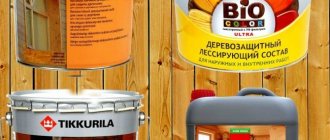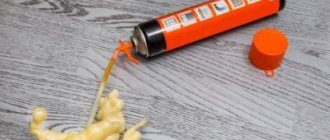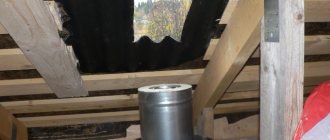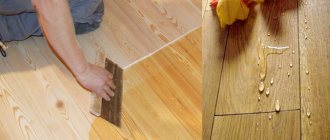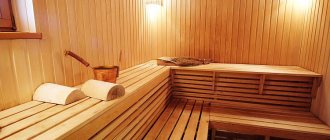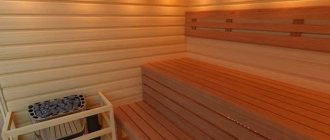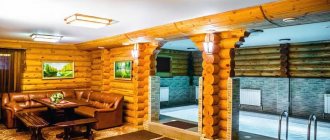Criterias of choice
For all its advantages, wood is susceptible to moisture. Over time, it dries out, darkens and begins to rot. Mold and microorganisms may appear on it. All this is true for normal external conditions. And in the steam room the conditions are extreme. Even in the dressing room there are no such impacts on the walls and floor. The influence of sudden changes in temperature and humidity in the steam room accelerates the destruction of wood. When exposed to high temperatures, conventional protective coatings can release harmful substances.
In addition, a steam room is not just a room in which a person is located. He remains there naked, his body in contact with wooden surfaces. And on some it even lies. This means that for shelves and benches you need to choose wood protection that will not be unpleasant upon contact.
Most often in the steam room they try to preserve the natural color of the wood, selecting species that look beautiful. But if you want to paint part of the steam room, then you need to take this into account when choosing an impregnation. Not every impregnation is suitable for subsequent painting.
Wood color after different impregnations Source elka-palka.ru
It is clear that it will not be possible to find the same impregnation for a bathhouse outside and inside. Even different parts of the steam room may require different protective equipment. Wood treatment in a steam room should be carried out with compounds adapted to its conditions. And the choice must be based on the following criteria:
- Which part of the steam room is the product intended for?
- Will it be primary impregnation of wood, or re-coating of a previously protected surface?
- Method of applying a protective substance to a wooden surface - with a brush, roller or spray
- Are there plans to further paint the impregnated wood?
Useful video
The video below advertises “Neomid 200”:
But Tikkurila made an advertising video that talks about what affects wood and how to deal with it - from products to application technology:
***
Have you ever used any antiseptic in your bath? If yes, share your experience and impressions in the comments.
By the way, there is still a lot of interesting things on our website. For those who would like to keep abreast of updates, we recommend subscribing to our channel on Telegram.
Ceiling
Perhaps the least requirements are placed on this part of the steam room. It is exposed only to the temperature effects of steam. Water almost never reaches it. Therefore, it can simply be coated with a specialized bath varnish.
The ceiling in the bathhouse must be reliably protected from dampness and temperature Source eco-ceiling.ru
See also: Catalog of companies that specialize in paints and varnishes.
Floor
Unlike the ceiling, all the water that is used in the steam room ends up on the floor. Therefore, the anti-water protection for floor boards must be very good. In addition to antibacterial and anti-water impregnation, it is advisable to cover the floor with a protective layer of varnish. But not every varnish is suitable for the floor. The protective layer should not be slippery. This is a must to protect the floor. Of course, the soles of your feet should not stick to the floor. Do not think that repeatedly coating the floor with varnish increases its safety. The thick layer of varnish cracks and water reaches the wood. In addition, the wood cannot “breathe” through such a coating and will still deteriorate.
When building a bathhouse, do not forget about impregnating the logs on which the floor boards are laid. This, of course, is not the inside of the bathhouse, and there are no special protection requirements for them. But if water gets to them, then sooner or later the floor inside the bathhouse itself will suffer, no matter how well it is protected.
Walls
Most of the impregnation for the bathhouse inside is spent on protecting the lining, which is usually used to line the walls. Therefore, you should not use impregnations and varnishes that, when heated, can release strong-smelling substances. And do not cover it with a protective layer that does not allow the wood to “breathe.”
Improper use of protective compounds can lead to the regular appearance of condensation on the walls of the bath Source synteko.in.ua
Shelves and benches
The shelves are the main part of the entire steam room, for which it is, in fact, built. Lying on it should be comfortable, pleasant and safe for health. Wood is a poor heat conductor, so even at high temperatures you won’t get burned by it. It’s another matter if it is covered with a protective film, which can cause a burn if touched. Therefore, it is not recommended to use paints or varnishes for it. It is better to apply a special impregnation for the bath. Often such impregnations are wax-based.
The requirements for the safety and convenience of the surface of shelves and benches are so high that there are bathhouse lovers who believe that wood should be natural for them and not covered with anything at all. But this is still suitable for small bathhouses, where simple shelves can be replaced. And when real furniture masterpieces are built, it is better to find a high-quality composition and ensure their durability.
It’s not enough to create beauty – you also need to protect it Source m.yukle.mobi
Protective compounds and their properties
For the sake of order, it is necessary to mention such a remedy as drying oil, which used to cover all the insides in the bathhouse. It is still used today, but it should not be used in a steam room. It will be cheap, but cheerful. In terms of protective properties, this is yesterday, and the smell from it when heated well is not pleasant.
Water-dispersed impregnations
They are made on a water basis, so they penetrate deeply into the wood structure. They are resistant to high temperatures, do not contain active chemical components and do not emit any harmful compounds when heated. Modern water impregnations contain antibacterial components. Available both colorless and with added dyes.
The disadvantage is their fragility. Over time, under the influence of water, they are washed out of the wood, so the impregnation must be renewed every two years.
Oil impregnations and varnishes
They impregnate and protect wood well from moisture, forming a film. But their inherent smell is a significant drawback. Therefore, they must be used with caution in the steam room. They are quite suitable for external impregnation and for protecting wood in the dressing room.
The varnish preserves the appearance of the wood, giving it a mysterious shine Source freepatriot.club
Acrylic based varnishes
Acrylic varnish for baths inside is considered safe. A modern product made from polyacrylates and organic solvents. Environmentally friendly and more durable than conventional water-dispersed products. Acrylic varnishes produced for baths and saunas necessarily contain antifungal components.
Water-based polyurethane varnish
Combines the advantages of water-dispersed and alkyd varnishes. It appeared on the market relatively recently, so it should be treated with caution, as with any new product. And its price is quite high.
Wax-based impregnations
Wax, like drying oil, has long been used to protect and add shine to wooden surfaces. Nowadays purely wax impregnations are almost never used. It is common practice to add wax to protective products based on other components.
In addition to protective products, special detergents are also produced for cleaning and bleaching wood. They are used both before applying protection and for washing dirty and darkened surfaces.
Processing inside: how to process - methods and technologies
How to treat a bathhouse with an antiseptic? There are three methods (minimum) suitable for these purposes. They will differ in the depth of impregnation. Well, let’s describe the fourth, the best, but requiring industrial equipment.
The simplest and most accessible method for everyone is to apply the solution to the surface of the wood using a roller or brush, or if you have one, use a spray bottle. This is done several times as the previous layer dries. The number of layers is usually specified by the manufacturer in the instructions. The penetration depth of the antiseptic is minimal - up to 5 mm, but more often 2-3.
Antiseptic (impregnated) edged board, pine. Photo Pilomaterialy.rf
The second method gives a slightly greater depth of impregnation and at the same time requires some equipment. For prepared (cleaned to wood) lumber, a “bath” is made - for example, it can be dug in the ground in the form of a trench of the required length and covered with polyethylene.
An antiseptic solution is poured into the bath, and the lumber is completely immersed in it for several days. The number of days depends partly on the type of wood. Let's say that spruce always needs more time to soak than pine.
The third method can also somehow be implemented on the site. To impregnate boards, for example, sand is soaked in antiseptic, and then stacks of prepared boards are layered with this sand. The stack of sand is covered with films and left for a couple of weeks. It is assumed that the film will protect the antiseptic from evaporation, and the wood will absorb it through osmosis.
The fourth method is beyond the capabilities of the owner of the site (for independent implementation). is already needed here . This is an industrial impregnation, which is called impregnation. The deepest, most effective. Lumber impregnated with a suitable antiseptic is sold everywhere, they are green or brown, a good manufacturer uses a product from Britain called “Tanalit” - it does not work only against one class of house rot - basidiomycetes, it resists everything else well.
Protective products for baths from different manufacturers
When processing wood inside a steam room, you should not experiment too much. You need to choose varnishes and impregnations made specifically for baths and saunas. Those who produce such products take into account the conditions and requirements for such premises.
The Finnish company Tikkurila is considered the leader of such products.
- Supi Saunasuoja – water-based impregnation with acrylic. Suitable for temperatures above 100 °C. A universal product for internal protection of steam rooms. Available in both a colorless version and a form suitable for tinting.
Impregnation Supi Saunasuoja Source marketut.ru
- Supi Laudesuoja – oil impregnation suitable for covering shelves
- Supi Saunavaha is a wax-based varnish. It is also considered universal and suitable for any bath surfaces.
Imported compounds have one drawback - the price. Domestic manufacturers provide cheaper products. Here are some designed specifically for bath conditions:
- Senezh sauna is an acrylate-based antiseptic to protect wood in saunas. Contains antimicrobial agents but is odorless.
- NEOMID 200 – antiseptic for wooden bath surfaces, including shelves and benches.
- NEOMID Sauna is a translucent acrylic-based varnish. For protecting and finishing wood in rooms with high humidity.
NEOMID Sauna varnish for baths Source gros-stroi.ru

